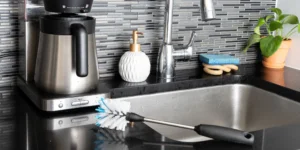A cold-brew espresso maker is a great investment for any espresso enthusiast who appreciates the clean, wealthy flavors of cold-brew coffee. However, to enjoy the advantages of this brewing approach, retaining your espresso maker is critical. Regular and thorough cleansing ensures that your cold-brew espresso maker maintains the delivery of scrumptious espresso, even by stopping any buildup of espresso oils, residues, or mildew. Proper safety now not only extends the lifespan of your coffee maker but also guarantees that each batch of bloodless brew tastes as fresh and colorful as the final. In this manual, we can walk you through a detailed and comprehensive method for cleansing your cold espresso maker. From instant submit-brewing rinses to deep cleaning sporting activities, we’ll cover the whole thing that will help you keep your coffee maker in pinnacle form, allowing you to experience your cold brew with a fantastic, feasible flavor.
Instructions to Clean Your Virus Mix Espresso Producer
Keeping a smooth, cold-brew espresso producer is basic for keeping up with the flavor of your coffee and prolonging the life expectancy of your gear. Legitimate cleaning ensures that each clump of cold blend tastes as bright as the first. Here’s a complete, step-by-step manual for cleaning your bloodless brew espresso maker very well:
1. Immediate Post-Brewing Rinsing
Disassemble: After brewing, disassemble your bloodless brew coffee maker by removing all removable parts, along with the carafe, filter, and lid.
Rinse: Immediately rinse these parts with hot water to remove coffee grounds and residues. This preliminary rinse prevents coffee from drying and sticking, which makes cleansing less difficult.
2. Detailed Cleaning of the Carafe
Soap and Water: Fill the carafe with hot water and add a few drops of mild dish-cleaning soap. Use a smooth, non-abrasive sponge or brush to wash the interior of the carafe. Pay special attention to any coffee stains or residues that might dangle on the edges or backside.
Rinse Thoroughly: After scrubbing, rinse the carafe thoroughly with hot water to make sure that no soap remains. Leftover cleaning soap can affect the taste of future brews.

3. Cleaning the Filter
Paper Filters: If your espresso maker uses paper filters, surely discard them after every use. Replacing them with every brew prevents any vintage espresso residues from affecting the taste of your bloodless brew.
Metal Filters: For metal filters, rinse them under warm water once after use. Use a tender brush or fabric to put off any trapped espresso grounds. Ensure you get into all the crevices to prevent buildup.
4. Weekly Thorough Cleaning
Disassemble: Once every week, disassemble all detachable elements of your coffee maker, along with the carafe, filter, lid, and some other removable components.
Wash with soap: Wash those components with hot water and mild dish soap. Use a gentle brush or sponge to scrub all surfaces, specializing in regions that might trap coffee oils and grounds, such as the clear-out basket and any small crevices.
Rinse and Dry: Rinse every part thoroughly with hot water to cast off all cleaning soap residue. After rinsing, dry every component absolutely with an easy, dry towel or allow them to air dry. This prevents mold from increasing.
5. Monthly Descaling
Prepare Solution: If you stay in an area with tough water, descale your coffee maker as soon as every month to save on mineral buildup. Mix identical elements: water and white vinegar.
Run the Descaling Cycle: Empty the vinegar arrangement into the repository and run a total fermenting cycle. This considers the disintegration of any mineral stores that might have been gathered.
Flush Completely: In the wake of walking the descaling cycle, dispose of the vinegar and run a few patterns of clean water through the coffee maker to get rid of any leftover vinegar and buildup.
6. Cleaning the Outside
Wipe Down: Utilize a sodden material to wipe down the outside of the coffee producer. For obstinate spots, utilize a gentler cleaner. Stay away from the use of grating substances or cleaners that could scratch or mar the surface.
Dry the Surface: In the wake of cleaning, dry the outside with a smooth material to forestall water spots and guarantee a smooth, clean appearance.

7. Final Drying and Reassembly
Ensure Complete Drying: After cleaning, make sure all components are completely dry before reassembling your coffee maker. This helps save you from mold and mold growth, ensuring your espresso maker remains in an ideal situation.
Reassemble: Once all parts are dry, reassemble your espresso maker. Store it in a dry, cool area until you’re prepared to apply it once more.
8. Routine Checks
Constantly check for deterioration signs, such as cracks and other damage to parts. To keep your espresso creator functioning properly, replace any damaged parts as soon as possible. You can maintain your cold-brew espresso creator running smoothly and in excellent condition by adhering to these specific guidelines. If you regularly clean and maintain your coffee creator, your cold brew will taste better and last longer. Enjoy the process and the crisp, flavorful cold brew that a well-kept coffee machine provides!
Conclusion
In the stop, a smooth-to-brew coffee maker is essential for enjoying the exceptional taste of espresso and retaining the durability of your equipment. By adhering to a normal cleaning habit, which includes instant rinsing, weekly washes, and monthly descaling, you reduce your residue buildup and make sure each cup of cold brew is as sparkling as possible.
Properly cleansing every carafe and filter, at the side of preserving the outside of your coffee maker, contributes drastically to the overall performance and flavor of your cold brew. Routine inspections and timely replacements of worn additives further beautify the performance and durability of your coffee maker. With those distinct cleansing and renovation practices, you’ll no longer only maximum efficaciously enjoy a constantly delicious bloodless brew but also keep your espresso maker operating at its best for years. Sharing the one practice with fellow coffee fans will help them get satisfaction from their cold brew to the fullest.

FAQ’s
Q1: How frequently would it be a good idea for me to clean my virus-brew espresso producer?
You ought to wash all removable parts after each use to prevent coffee beans from drying and sticking. Play out an exhaustive cleaning with cleanser and water once per week, and complete a profound cleaning and descaling once a month.
Q2: What’s the most effective way to clean the carafe?
Fill the carafe with warm, foamy water and utilize a non-rough wipe to clean within. Focus on any espresso stains or buildups. In the wake of cleaning, flush completely with warm water to guarantee no cleanser remains.
Q3: How would I clean various sorts of channels?
For paper channels, dispose of them after each use. For metal channels, flush under warm water and utilize a brush to eliminate any caught grounds. Material channels ought to be washed, soaked in a water-vinegar arrangement, and bubbled intermittently to eliminate oils and buildups.
Q4: How would I descale my Virus-Brew espresso creator?
Blend equivalent amounts of water and white vinegar. Empty the combination into the repository and run a fermentation cycle. After the cycle, dispose of the vinegar arrangement and run a few patterns of clean water to eliminate any excess vinegar and buildup.
Q5: Could I at any point utilize normal, regular water to clean my espresso maker?
Indeed, however, utilizing separate water is recommended for washing and fermenting to stay away from contamination that can influence the type of your virus brew.
Q6: How would I clean the outside of the espresso producer?
Wipe the outside with a moist fabric. Utilize a gentle cleaner for difficult spots, keeping away from grating materials that could start to expose what’s underneath. Dry the outside with a delicate material to forestall water spots.
Q7: How would I forestall shape and mold in my espresso producer?
Guarantee all parts are totally dry before reassembling and putting away your espresso maker. Consistently clean your espresso maker to forestall mold and buildup development.
Q8: How would it be a good idea for me to respond if my espresso producer gives indications of mileage?
Consistently examine your espresso producer for breaks or damaged parts. Supplant any ragged parts immediately to keep up with usefulness and forestall breaks or glitches.
Q9: How long does the cold mix gather rearward in the cooler?
Cold brew concentrate ordinarily endures as long as about fourteen days in the fridge; however, it is best consumed in something like seven days for the ideal character. Continuously store it in a hermetically sealed holder.
Q10: How might I let you know if my espresso producer needs descaling?
On the off chance that you notice decreased preparation proficiency, slower stream rates, or unusual preferences, it may be time to descale. Ordinary descaling consistently can forestall these issues and keep your espresso maker in great shape.
Q11: What would be a good idea for me to use for profound cleaning?
For profound cleaning, utilize a combination of water and white vinegar (1:1 proportion). Absorb the removable parts for around 30 minutes, then, at that point, wash completely.
Q12: How might I guarantee that everything is cleansed during cleaning?
Flush all parts completely with warm water after washing. If necessary, play out an extra flush cycle to guarantee no cleanser buildup remains, which can influence the flavor of your espresso.




